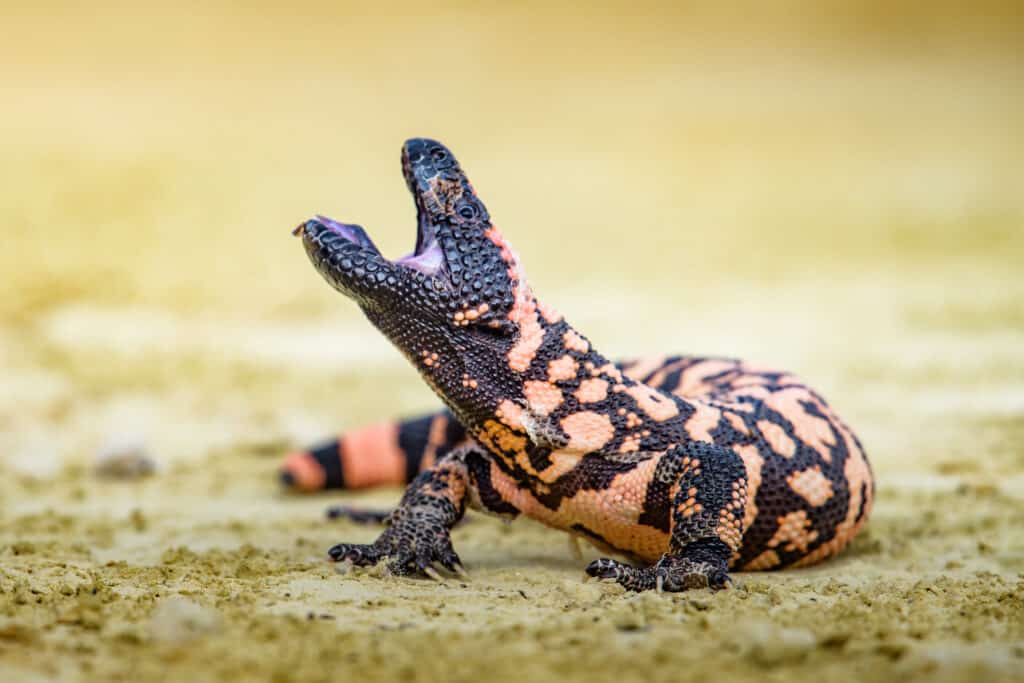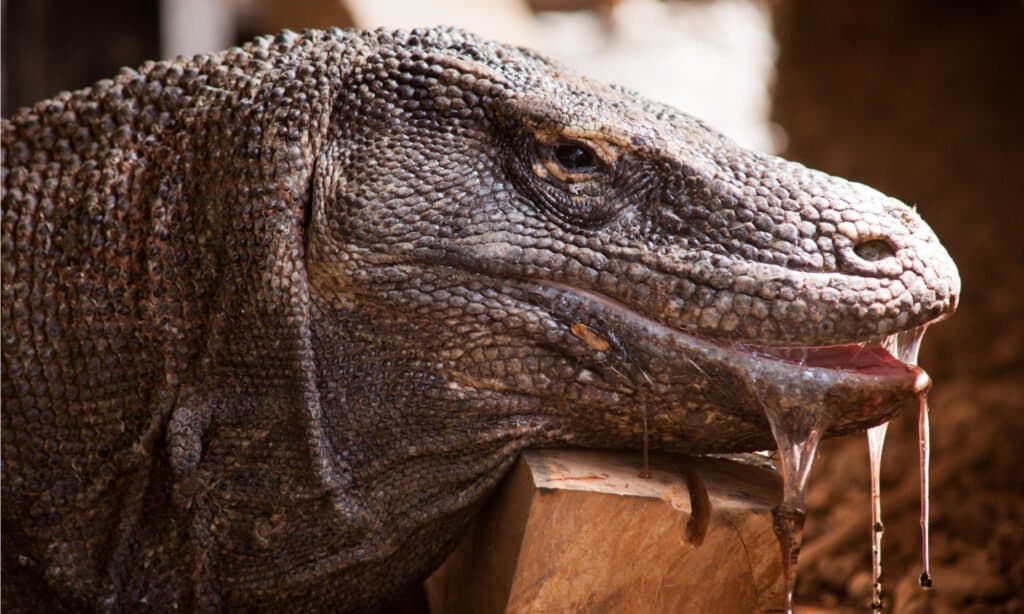When we talk about the biggest or most dangerous reptiles in a given area, context is everything. One of the largest lizards and also the most dangerous in the United States is the Gila monster. However, that reptile is certainly not the largest or deadliest reptile in the world. Today, we’re going to compare the monitor lizard vs Gila monster and show you what makes them different.
We’ll show you whether North America’s perilous lizard is a match for the more widespread monitor lizard species.
Comparing a Monitor Lizard and a Gila Monster

| Monitor Lizard | Gila Monster | |
|---|---|---|
| Size | Weight: 2.2-366lbs Length: 0.6 ft-10 ft overall | Weight: 3-5lbs Length: 1ft-2ft overall |
| Venom | – Is partially venomous – Introduces venom through saliva during bites – Different species’ venoms vary in strength, but they typically disrupt clotting abilities and help induce shock | – Highly venomous – Harmful but rarely, if ever, fatal to humans – Uses modified salivary glands to produce venom in its jaws – Venom is introduced to the lower part of the teeth and then transfers during a bite |
| Appearance | – Often long, heavy-bodied, and has a long tail – Has a body shape like most lizards – Scaly, less obvious osteoderms – Colors include green, brown, gray, tan, blue, black, white, and others | – Moderate length with a thick body and a moderately sized tail – Obvious osteoderms in their scaly skin – Often black with patterns of pink and orange |
| Diet | – Primarily carnivorous – Eats fish, reptiles, birds, mollusks, insects, and more – Komodo dragons primarily eat deer | – Primarily carnivorous – Eats small mammals like mice, squirrels, and rabbits – Snakes, frogs, insects, and eggs |
| Location | – Africa, Asia, Oceania | – North America |
| Scientific Classification | – Squamata order – Varanidae family – Varanus genus | – Squamata order – Helodermatidae family – Heloderma genus |
The 6 Key Differences Between a Monitor Lizard vs Gila Monster

Gila monsters are small, thick-bodied, and venomous.
©Vaclav Sebek/Shutterstock.com
The greatest differences between a monitor lizard and a Gila monster include their size, location, and appearance. Monitor lizards are long, sometimes heavy, scaly lizards found in Africa, Asia, and Oceania that can grow up to 366 pounds and 10 ft in length. Gila monster is a shorter, thick-bodied lizard with osteoderms that can weigh up to 9 pounds and grow about 2 feet long.
These differences may not seem too great at first glance. However, when we compare more traits of these creatures, their dissimilarities will become more apparent.
Monitor Lizard vs Gila Monster: Size
Monitor lizards tend to be longer than Gila monsters. To qualify that statement, we mean that the larger monitor lizards, the genus of lizards with the greatest size, can measure several feet in length and weigh hundreds of pounds. For example, the largest monitor lizards, Komodo dragons, have reached sizes of 10 feet long and 365 pounds!
When you hear the name Gila monster, you might assume it’s the size of a saltwater crocodile. However, the Gila monster only measures about 22 inches long at its largest, just shy of 2 feet. It only weighs between 3 and 9 pounds. Relatively speaking, this is a large lizard in its part of the world. However, it’s a tiny reptile compared to the biggest monitor lizards.
Monitor Lizard vs Gila Monster: Venom

The Gila monster has toxic venom that can easily kill its prey.
©iStock.com/kwiktor
Most monitor lizards are believed to be at least partially venomous. They do not have the stopping power of a cobra, but their venom does work. These creatures have venom in their saliva, and this venom disrupts blood clotting processes and helps induce shock in prey.
However, Gila monsters are highly venomous, and their venom is said to be as toxic as a rattlesnake’s. They produce venom in glands under their jaw and then bite it into the wounds of their prey. This venom can paralyze prey and causes internal organs to hemorrhage.
Although the bites from these animals are painful to humans, no fatalities have been reported in nearly a century. These reptiles are very sluggish and slow to anger. The same cannot be said about monitor lizards. They can move over 28 mph in some cases, and they have killed people in the few decades.
Monitor Lizard vs Gila Monster: Appearance

Many monitor lizards have a passing resemblance to Gila monsters
©Vladislav T. Jirousek/Shutterstock.com
A Gila monster and a monitor lizard of the same size would mostly resemble each other. However, they do have some unique qualities. For example, Gila monsters have a very thick midsection that is somewhat disproportionate to the rest of their bodies. Monitor lizards are heavy-bodied, but not thick like them.
Both creatures have osteoderms in their scaly skin, but the structures are more obvious in the Gila monster. This could be due to the darker skin tones of the monitor lizard. These reptiles tend to be green, brown, gray, tan, and black, but they can also have other colors, too.
Gila monsters are black with patterns of pink and orange or very light pink that looks white.
Monitor Lizard vs Gila Monster: Diet
Both monitor lizards and Gila monsters are carnivorous. However, they differ in the foods they can eat. A lot of monitor lizards will opt for fish, reptiles, birds, and insects, but the largest ones primarily eat deer. That’s right, they’re so large and deadly that they can eat a deer.
Gila monsters eat small creatures like insects, snakes, and eggs along with a smattering of mammals.
In short, monitor lizards go for large prey and Gila monsters do not.
Monitor Lizard vs Gila Monster: Location
The Gila monster can be found in the United States and Mexico. However, they only live in the hot and arid portions of the Southwest U.S. and the northern portions of Mexico.
Monitor lizards are a large genus, and they live in Asia, Africa, and Oceania. The species vary in size, location, and the frequency with which they’re seen.
Monitor Lizard vs Gila Monster: Scientific Classification
Although they may look similar, they belong to different groups. Both reptiles are part of the Squamata order, but they differ at the family level. Monitor lizards belong to the Varanidae family and Gila monsters belong to the Helodermatidae family.
Monitor lizards are from the Varanus genus, and Gila monsters occupy the Heloderma genus. These animals are not very closely related, but they do share common areas in their family tree.
Monitor Lizard vs Gila Monster: Who Would Win in a Fight?

A
Komodo dragon
would eat a Gila monster and still be hungry.
©Luca Vaime/Shutterstock.com
A large monitor lizard would have no problem killing and eating a Gila monster. A Komodo dragon would shred the little lizard before it could think to bite it back. However, if the two animals were the same size, the more venomous Gila monster would have the edge in the fight.
Still, monitor lizards tend to be fast and aggressive when killing their foes. Gila monsters are lethargic when they’re not actively hunting.
That would allow any lizard the same size as the Gila monster or larger to put up quite the fight against them, venom or not. That’s especially true when you consider the toughness of the monitor lizard’s scales and the question of if the Gila monster can muster enough power to bite through them.
If we put the deadliest Gila monster against the deadliest monitor dragon, we have to go with the latter to win.
The photo featured at the top of this post is © MattiaATH/Shutterstock.com
Thank you for reading! Have some feedback for us? Contact the AZ Animals editorial team.






